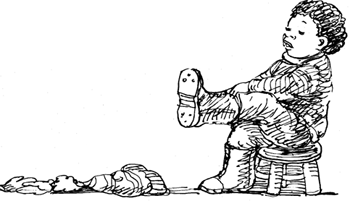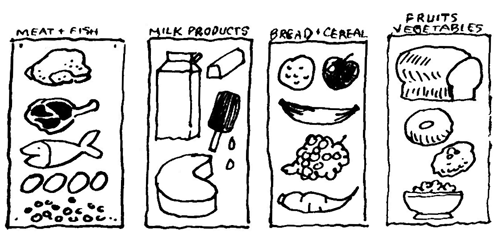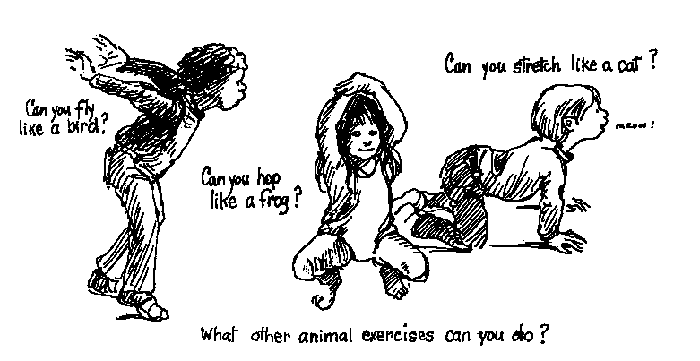|

Chapter Eight
Theme: Health
|
A good month in which to explore this theme is January, the start of the new calendar year and one of the coldest winter months. Often winter is a time when children suffer from common colds, sore throats, and earaches. Helping to understand how to stay healthy may help them improve their well-being. The goals of this unit are to help children understand the importance of good health and to help them learn how to promote their own good health.

Language Arts: Oral Language
Fingerplay
Five little monkeys (place five fingertips on 'bed,' which is palm)
Jumping on the bed, (make five fingers jump)
One fell off and bumped his head. (rub head)
Mama called the doctor (hold phone to ear and dial)
And the doctor said: "That's what you get for jumping on the bed!" (shake finger to scold)
Four little monkeys, etc. (make 4 fingers jump)
Three little monkeys, etc. (make 3 fingers jump)
Two little monkeys, etc.
One little monkey jumping on the bed,
He fell off and bumped his head.
Mama called the doctor,
And the doctor said:
"No more little monkeys jumping on the bed!"
DISCUSSION QUESTIONS: What are some different ways children get hurt? How can children prevent themselves from getting hurt? What safety rules do we have to help children stay healthy?
Language Arts: Listening
Listening to (and Giving) Instructions
Explain that when grown-ups tell children how to take care of themselves, they want children to listen to them. Have some props ready so that the children can take turns dressing up as grown-ups and telling the other children different ways to take care of themselves. The props might be a man's jacket and hat and a woman's shawl and hat. Encourage the children to think of different instructions grown-ups have given them for taking care of themselves, such as what to do when you fall down and get cut, how to brush your teeth, how to wash your hands, how to keep from spilling on yourself when you eat, how to cross streets, and what to do if you feel carsick. Perhaps to facilitate this talking-and-listening game, you might ask the listening children to pretend they are younger than they are-three-year-olds, perhaps.
Language Arts: Writing
Washing Instructions
Ask the children to be "dolls' clothes washers." Have them dictate to you a process for washing the class doll clothes. Take their dictation down on the chalkboard, revising the process as the children revise it in their discussion. Elicit from the class the following steps: get materials, set up area for washing, wash, rinse, hang clothes to dry, and clean up washing area. When the class has agreed on a washing process that suits your classroom, divide the children into groups to do different steps of the process. Change groups from time to time. Take photos of the process or, later, have the groups draw pictures of the process. The children can write or dictate "washing instructions" to go with the pictures.
Looking at Dirt Through a Magnifying Glass
Provide magnifying glasses so that the children can look at dirt and grime on their hands, clothing, toys, and vegetables such as celery. Have them draw "before" pictures and write descriptions of what they see. Then, help them clean the dirt and grime away. Have them look again through magnifying glasses at the clean objects. Have them draw "after" pictures and new descriptions of what they see.
HINT: In cold areas, on a day when it is snowing lightly, take a magnifying glass outside and help the children look at snowflakes on their jackets. How many points does a snowflake have? (six) Back in class have the children draw "magnified" snowflakes with chalk on black paper, and write stories about them. Another art activity is to glue three popsicle sticks together to make a snowflake. Dribble paint on the sticks, and sprinkle with white glitter. Dry and suspend with string to decorate the classroom.
Language Arts: Reading
Reading Labels
Establish a bulletin board for collecting labels from cans and boxes. If you like, send home a note to parents requesting their help with the collection. Make a display of the labels, encouraging the children to read them and identify letters they know. Talk about the sounds the letters make. Save duplicate labels to make a matching game. Together, read the labels on classroom games and books. Draw pictures of new labels for familiar products or invented ones.
If you like, show the children the words sugar and salt listed in the ingredients list on food packages. Explain that eating too much sugar and salt is unhealthy. Have the children be "sugar and salt detectives" looking for foods that have these ingredients. Explain that if these ingredients are listed first in the list, they are the ingredients used most in the food.
Show the children the word and symbol for POISON on a container of poisonous material. (Perhaps the custodian could visit the class with some samples.) Teach the children never to eat or drink anything with that label.
Carrot Story
Have the children dictate and illustrate class stories about carrots and other healthful foods to eat. Display the stories and help the children reread them from time to time. Encourage visiting parents to play "secretary" with their children, taking down their children's dictation for rereading and display.
CARROTS ARE GOOD.
YOU EAT CARROTS.
YOU CAN MAKE CARROT SOUP.
THIS CARROT IS BIG.
CARROTS GROW OUT OF THE GROUND.
CARROTS ARE GOOD TO EAT WITH PEANUT BUTTER,
RABBITS LKE CARROTS.
Social Studies
People Who Help Us Stay Healthy
Together, brainstorm a list of people who help other people stay healthy. List the people on an experience chart with a little illustration for each one. Ask the children to dictate a sentence or two explaining how each "health helper" helps people stay healthy.
If possible, invite some of these people to class to tell about their job. Ask them to bring special clothes they wear and some equipment they use to show the children. Have the children prepare ahead of time some questions to ask. They may need to practice asking the questions ahead of time in order to remember them and overcome shyness.
Solving Problems
Explain that people can be problem solvers and that solving problems wisely can help people be healthy. Spill a little water on the floor in the classroom. Ask the children, "How is this water a problem?" Elicit the answer that someone could slip on it. The children may think of other ways it is a problem-good; encourage many different answers, explaining that the more ideas we have for identifying and solving problems, the better problem solvers we are. Talk about ways to solve the problem of water on the floor in the classroom. Select a way that suits your classroom, and let a child do it, perhaps mopping up the water with paper towels. Ask the children to suggest problems to think about. If they can't act out problems for real in class, they can pretend.
Set out other problems for the children to identify and solve, such as: Why is broken glass a problem and what can we do about it? Why are matches a problem, and what can we do if we find them? Why is too much noise sometimes a problem, and what can we do about it? Why is too much activity and no rest a problem, and what can we do about it? Why is too much sitting and no activity a problem, and what can we do about it?
The Four Food Groups
Explain that there are four food groups: (1) meat, fish, poultry, eggs, and beans, (2) milk products, (3) breads and cereals, and (4) fruits and vegetables. Make a bulletin board display divided into four parts. Have the children contribute drawings and photographs of foods to sort into the four categories. Explain that a healthful meal has some foods from each group in it. Together, make and illustrate menus of favorite healthful meals. If possible, plan and make a healthful meal to serve in class. Talk about where the different foods come from and what kinds of workers bring them to us.

Science
How to Stay Warm
Fill three containers with warm water. Let the children feel the water to see that it is warm. Take the water's temperature and record it on a graph. Ask them, "How can we keep the water warm?" Encourage them to think of many different ways, such as putting a hat on a container and covering a container with a lid and a balnket. Together, select two ways to keep the water warm and enact these methods in the classroom. Leave the third container uncovered, asking the children which container of water will cool off first. An hour or two later, test the water again, recording temperatures again. Discuss questions, such as: Which water stayed warmest? Why?
Discuss ways to keep one's body warm outside in cold weather. Have the children "show and tell" about jackets, hats, mittens, and so forth that they wore on the way to school to keep warm.
How to Cool Off
Explain that sometimes when we get too hot, we need to cool off. How can something hot be cooled? How can hot cocoa be cooled? If possible, make and serve hot cocoa in the classroom. Encourage the children to think of different ways to cool their cocoa so they can drink it, such as by waiting until the air cools it, by holding spoonfuls of cocoa up to the air until they are cool and then drinking them, by blowing gently on the cocoa, by adding cold milk to the cocoa.
Ask the children, "When you get hot inside your snowsuit on a cold day, how can you cool off?" Encourage different kinds of answers, such as by taking off your hat, by unzipping your jacket a little, and by stopping running for a while. Ask "Would it be a good idea to take your snowsuit off? Why not?"
Ask the children to dress up pin the classroom in their winter overclothes and show how they cool off when they're outside. If you live in a sunny, hot area, ask children to "show and tell" how they cool off in the sun, such as by wearing a sun hat, by splashing water on themselves, and by making a fan from paper.
How to Stay Dry
Do water absorption tests in the science center. Have children bring in items they want to test to see if they soak up water or not. Have the children make predictions, then test their items by dropping water on them. Record the results with pictures on charts. Ask the children to "show and tell" how they stay dry on a rainy or snowy day.
Math
How Many Bags of Flour Do You Weigh?
Weigh each child on a regular bathroom scale. Explain that the bathroom scale gives weight in pounds. Show the children how heavy one pound is by showing different kinds of food for snacks that weigh one pound, such as a one-pound box of raisins or a one-pound bag of apples. You will probably discover that kindergartners weigh about forty-four pounds, some more, some less.
On a sunny day have the children weigh themselves with bags of flour on the seesaw. To do this, you need to have a cardboard box, eight 5-pound bags of flour, three 2-pound bags or boxes of flour, and a few 1-pound bags or boxes of flour. (If you can't get flour, use another ingredient. Perhaps you can borrow the ingredients from your school cafeteria, and perhaps another teacher or the custodian can help you carry them outside to the slide.) Have the children take turns sitting on one end of the slide as you add bags of flour to the box at the other end. Have the children help you count how many each child weighs. Record the amounts on a graph. In the classroom weigh dolls and stuffed animals on a pan balance scale. Make individual pan balance scales for weighing lighter items.
How Tall Are You?
Make a yarn graph to show how tall the children are. First, have the children draw portraits of their faces. Then measure them individually against the wall with yarn. Tape the yarn measurements to the wall, hanging the children's portraits above them so each child can find his measurement. Next to the graph, hang a tape measure. Help the children read the tape measure. (This is hard for kindergartners.) You will probably find that most kindergartners are about forty-four inches tall, some more, some less. Explain that eating good food and exercising help children grow the height they should be. It is natural for some children to be taller than others. Good vocabulary for this activity: tall, taller, tallest,' short, shorter, shortest.
Art
Fancy Fruit Platters
CONCEPT: We can serve healthy foods in beautiful ways. Provide cut-up fruit for the children to arrange in attractive ways on paper plates. After the children finish arranging the fancy fruit platters, they can discuss the designs and then eat them.
QUESTIONS FOR DISCUSSION: How can we arrange fruit in patterns? How can we arrange fruits to make pictures? (Try making bunny salads with pear halves for faces, bananas for ears, raisins for eyes, and carrot sticks for whiskers.)
MORE QUESTIONS FOR DISCUSSION: What other healthy foods could we arrange on platters? (Try fresh cut-up vegetables, such as carrot sticks, celery sticks, cut-up green pepper, cauliflower, broccoli, and tomato slices.)
Two Recipes for Soapy Finger Paints
1. Mix 1/2 cup laundry starch chips or powder, 1/2 cup mild soap powder, and 1/2 cup water.
2. Mix 1 cup water and 2 cups soap flakes. For both recipes, beat until thick with an egg beater. Divide into batches and add food coloring or tempera paint to make different colors. (These are good paints for getting children's hands clean.) Teach the children not to rub their eyes with hands covered with paint.
CONCEPT: People can express their feelings through art. Expressing their feelings can make people feel good and healthy.

To finger paint, have the children write their names in pencil on the slick side of dry finger painting paper. Then show them how to wet their paper with a damp sponge and how to finger paint on the wet surface. Encourage children to make finger paintings about different feelings, such as anger, happiness, and fear. Display the finished paintings, and talk about how they are alike and different. If you like, skip the paper, and finger paint on the table. Afterward, have the children clean the table.
Music
Lullabies and Marching Songs
Ask the children to think of different kinds of songs-songs for resting, going to sleep, counting, saying the alphabet, marching, starting the school day, and cleaning up. List the songs on an experience chart, each with a little picture to help the children read the titles afterward. Ask each child to pick a song and make an illustration for it. Write the title of the song on the illustration. When all the illustrations are done, ask the children to think of different ways to classify them. Make a book together of class favorite songs, putting various songs together in categories. Sing the songs, and discuss how the music in different categories is the same and how it is different. Ask "How are lullabies and marching songs the same? How are they different?" And "What is better for people, exercise or rest?" (Both are important.)
Safety Song
(Add this verse to the song "If You're Happy and You Know It, Clap Your Hands.")
If you're in trouble and you know it, Tell a friend.
If you're in trouble and you know it, Tell a friend.
If you're in trouble and you know it, Then your face will surely show it,
If you're in trouble and you know it, Tell a friend.
Make a Tape for Rest Period
Make a tape of the children singing their favorite lullabies and quiet songs. If possible, accompany the songs with music. If you can't play an instrument, perhaps an· other teacher, local musician, or parent can help you.
Let the children take turns borrowing the tape to bring home so they can listen to it with their parents at bedtime. Ask the children to tell you when they go to bed at night. If they don't know, ask them to find out for "homework" and to bring in on a slip of paper their bedtime written down. Make a graph of bedtime hours. Explain that people need sleep to stay healthy. The children might want to memorize the following poem to recite on their tape for rest period. Perhaps you can put it to music. A related art activity would be to draw and compare pictures of bedtime bedroom windows in summer and winter.
Bed in Summer
In winter I get up at night
And dress by yellow candlelight,
In summer, quite the other way,
I have to go to bed by day.
I have to go to bed and see
The birds still hopping on the tree,
Or hear the grown-up people's feet
Still going past me in the street.
And does it not seem hard to you,
When all the sky is clear and blue,
And I should like so much to play,
To have to go to bed by day?
- Robert Louis Stevenson
Physical Education
Exercises for Kindergarten
Can you fly like a bird?
Can you stretch like a cat?
What other animal exercises can you do?

What's Inside?
Have the children rest and pay attention to their bodies for a minute at the end of an exercise routine. This is a good time to think about what's inside the body and identify internal body parts.
|

